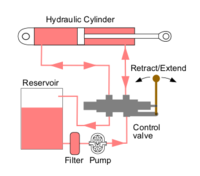
Photo from wikipedia
Vibration and acoustic emission have received great attention of the research community for condition-based maintenance in rotating machinery. Several signal processing algorithms were either developed or used efficiently to detect… Click to show full abstract
Vibration and acoustic emission have received great attention of the research community for condition-based maintenance in rotating machinery. Several signal processing algorithms were either developed or used efficiently to detect and classify faults in bearings and gears. These signals are recorded, using sensors like tachometer or accelerometer, connected directly or mounted very close to the system under observation. This is not a feasible option in case of complex machinery and/or temperature and humidity. Therefore, it is required to sense the signals remotely, in order to reduce installation and maintenance cost. However, its installation far away from the intended device may pollute the required signal with other unwanted signals. In an attempt to address these issues, sound signal-based fault detection and classification in rotating bearings is presented. In this research work, audible sound of machine under test is captured using a single microphone and different statistical, spectral and spectro-temporal features are extracted. The selected features are then analyzed using different machine learning techniques, such as K-nearest neighbor (KNN) classifier, support vector machine (SVM), kernel liner discriminant analysis (KLDA) and sparse discriminant analysis (SDA). Simulation results show successful classification of faults into ball fault, inner and outer race faults. Best results were achieved using the KLDA followed by SDA, KNN and SVM. As far as features are concerned, the average FFT outperformed all the other features, followed by average PSD, RMS values of PSD, PSD and STFT.
Journal Title: Acoustics Australia
Year Published: 2019
Link to full text (if available)
Share on Social Media: Sign Up to like & get
recommendations!